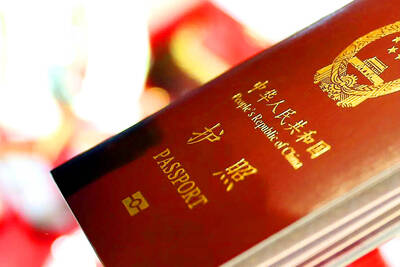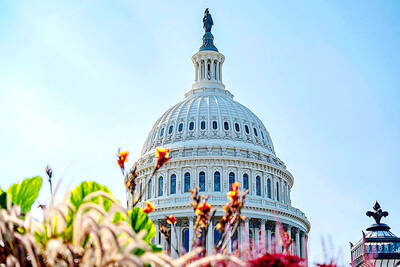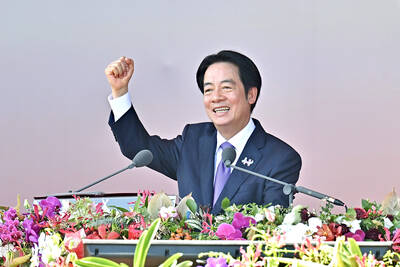Air travelers in the US can expect to be monitored, probed -- and hopefully protected -- by a handful of new security technologies, from chemical-sniffing detectors to computer cameras that scan crowds.
The devices could be installed in relatively short order at airports and on planes, aiming to keep hijackers and weapons from getting on board, and disarming those who do, experts say.

PHOTO: AP
Fliers could pay for the measures with a US$30 to US$50 a ticket surcharge, one expert estimated.
Agencies that handle security at airports, including the Federal Aviation Administration, US Customs Service and the US Immigration and Naturalization Service, had little to say about technology upgrades under consideration.
But experts point to a combination of devices that screen luggage, clothes and criminal backgrounds.
The first line of defense is aimed at keeping weapons and explosives off planes, said Rick Charles, who heads the aviation program at Georgia State University.
Travelers can expect more frequent searches of luggage, documents and clothes with particle detectors that can find traces of drugs or explosives and, in some cases, pathogens used in biological warfare, he said. Authorities will also probably call for more explosives-detecting resonance scanners that can hone in on tough-to-find plastic explosives, said Billie Vincent, president of Aerospace Services International and the FAA's former head of security.
Machines that can find bombs and guns provide no defense against passengers bent on destruction by other means -- such as the suicide-minded groups that hijacked the four airliners on Sept. 11.
To screen passengers, aviation authorities are considering biometric scanners that check identities against criminal records and terrorist watch lists, Charles said.
``Biometrics attempts to keep the wrong people off airplanes, instead of trying to keep bombs and weapons off airplanes,'' said Charles.
Face-recognition systems show promise in matching terrorists' mug shots -- garnered from files of the FBI, CIA or Interpol -- to faces roaming airport crowds. One such system was installed in June at Iceland's Keflavik International Airport. Others are under consideration here.
Biometric systems are already in use by Customs and the INS. The INS' INSPASS system uses hand-geometry scanning kiosks to permit entry to registered travelers. And Customs' new border-crossing cards for Mexicans store fingerprint data. Charles said fingerprint identity checks may also appear at check-in counters, where travelers' names and thumbprints are checked against watch lists and criminal records.
But without a US criminal record -- or at least a photo and some background information -- a terrorist will not be intercepted by a biometric security system.
``What if he's not in anybody's database? He'll walk right through,'' said Robert Mannal, of KPMG's information risk management office.
Security measures being proposed for aircraft themselves take this reality into consideration.
In Cleveland, ADR Investigation and Protection Corp. is discussing installing closed circuit television systems on the jetliners of three airlines, said company president Lex Rosenbaum. He would not name the carriers.
The systems would allow pilots to keep an eye on the passengers while sending streaming video to ground stations, where it could be monitored or stored for a later investigation, Rosenbaum said.
Experts stressed, however, that high-tech systems are merely aids for security personnel whose duties and powers also stand to be augmented.
``Most of this is feel-good stuff,'' Vincent said. ``It avoids taking the hard measures you need to do the job.'' He favors training pilots to handle sky marshal duties, giving them arms and discretion to kill a would-be hijacker before a passenger jet can be converted into a flying bomb.

The Ministry of the Interior (MOI) is to tighten rules for candidates running for public office, requiring them to declare that they do not hold a Chinese household registration or passport, and that they possess no other foreign citizenship. The requirement was set out in a draft amendment to the Enforcement Rules of the Public Officials Election and Recall Act (公職人員選舉罷免法 ) released by the ministry on Thursday. Under the proposal, candidates would need to make the declaration when submitting their registration forms, which would be published in the official election bulletin. The move follows the removal of several elected officials who were

FOUR DESIGNATED AREAS: Notices were issued for live-fire exercises in waters south and northwest of Penghu, northeast of Keelung and west of Kaohsiung, they said The military is planning three major annual exercises across the army, navy and air force this month, with the navy’s “Hai Chiang” (海強, “Sea Strong”) drills running from today through Thursday, the Ministry of National Defense said yesterday. The Hai Chiang exercise, which is to take place in waters surrounding Taiwan, would feature P-3C Orion maritime patrol aircraft and S-70C anti-submarine helicopters, the ministry said, adding that the drills aim to bolster the nation’s offshore defensive capabilities. China has intensified military and psychological pressure against Taiwan, repeatedly sending warplanes and vessels into areas near the nation’s air defense identification zone and across

SENATE RECOMMENDATION: The National Defense Authorization Act encourages the US secretary of defense to invite Taiwan’s navy to participate in the exercises in Hawaii The US Senate on Thursday last week passed the National Defense Authorization Act (NDAA) for Fiscal Year 2026, which strongly encourages the US secretary of defense to invite Taiwan’s naval forces to participate in the Rim of the Pacific (RIMPAC) exercise, as well as allocating military aid of US$1 billion for Taiwan. The bill, which authorizes appropriations for the military activities of the US Department of Defense, military construction and other purposes, passed with 77 votes in support and 20 against. While the NDAA authorizes about US$925 billion of defense spending, the Central News Agency yesterday reported that an aide of US

NATIONAL DAY: The ‘Taiwan Dome’ would form the centerpiece of new efforts to bolster air defense and be modeled after Israel’s ‘Iron Dome,’ sources said President William Lai (賴清德) yesterday pledged to strengthen the nation’s air defense capabilities and build a “T-Dome” system to create a safety net against growing military threats from China. “We will accelerate our building of the T-Dome, establish a rigorous air defense system in Taiwan with multi-layered defense, high-level detection and effective interception, and weave a safety net for Taiwan to protect the lives and property of citizens,” he said in his National Day address. In his keynote address marking the Republic of China’s (ROC) 114th anniversary, Lai said the lessons of World War II have taught nations worldwide “to ensure that